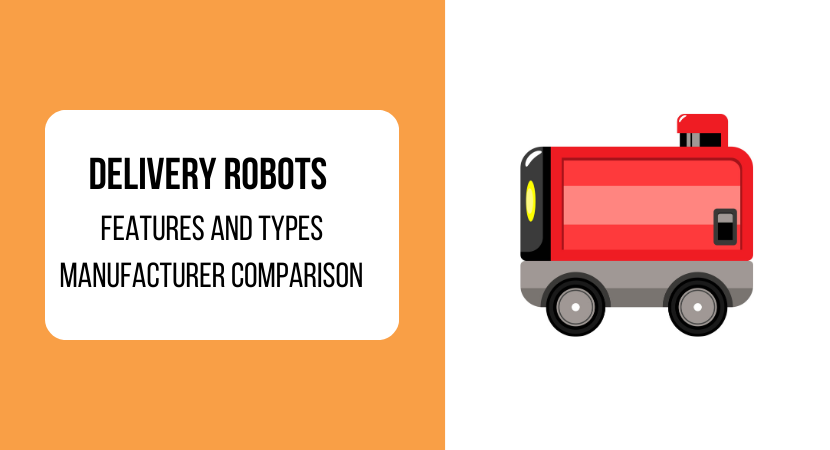Under such circumstances, delivery robots have emerged as a promising solution to address these issues and unlock fresh business prospects.
In this article, we will take a deep dive into the functioning and usage of delivery robots for B2B applications.
目次
What is a delivery robot
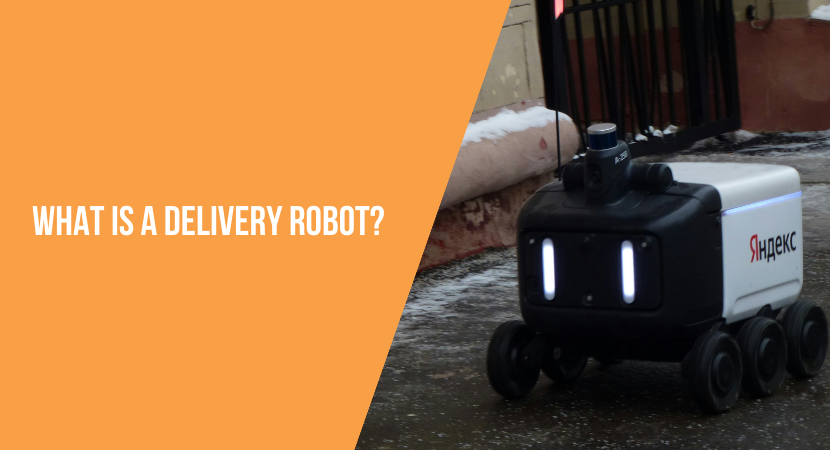
A delivery robot is a robot that automatically transports products and packages from distribution centers and retail stores to final consumers.
These robots are typically wheeled and move on the ground, using sensors and AI technology to navigate delivery routes while avoiding obstacles.
Many run on electricity and are considered an eco-friendly means of transportation.
Aerial delivery using drones has recently attracted attention, but delivery robots generally use roads and sidewalks.
(Reference: https://www.meti.go.jp/policy/economy/distribution/deliveryrobot/index.html)
This trend in the rising demand for delivery robots is because of the following reasons:
- Logistics companies have not been able to strengthen their workforce in time to cope with the rapid increase in demand for home delivery due to the expansion of the e-commerce market
- Labour shortage in the logistics sector, especially in developed countries, due to economic growth and declining workforce
- To strengthen the provision of services to people who have difficulty shopping on their own, such as the elderly and people with disabilities
As their popularity increases, delivery robots are expected to play an active role in the following environments.
- Residential lots in urban areas: Especially suitable for narrow roads and many obstacles
- University and corporate campuses: Automate and streamline the delivery of documents and packages across large campuses
- Elderly communities: Used for delivering everything from daily necessities to medicines to areas and facilities where many elderly people live
- Hospitals and medical facilities: Used when prompt delivery of urgent medicines, specimens, documents, etc. is required
- Tourist destinations and leisure facilities: Can be used for food and souvenir delivery services at large resorts and parks
Types of delivery robots
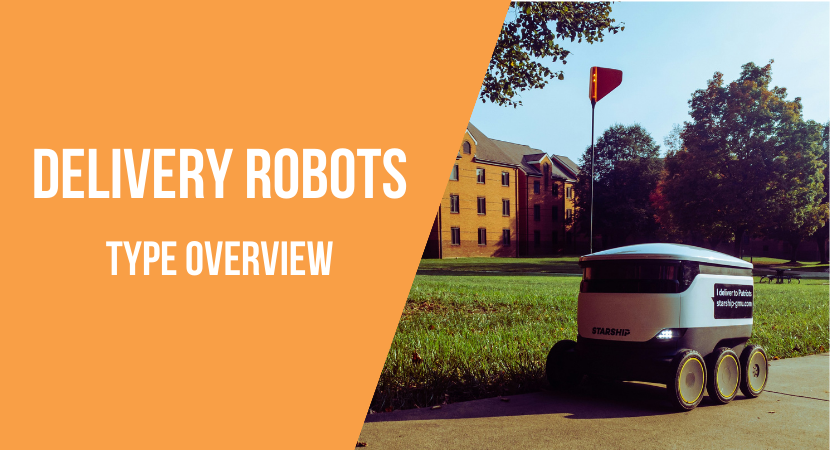
Now that we are more knowleageable about delivery robots, let us take a look at the main types. There are three main types of delivery robots:
- Land delivery robot
- Aerial delivery robot
- Self-driving truck
Land-based delivery robot
Land-based delivery robots are automated robots that move on the ground and transport packages. These robots are generally electrically powered and designed to operate in a variety of environments and terrains.This type of delivery robot can be further divided into three types:
- Dolly type
- Mini delivery robot
- Large delivery vehicle type
Dolly type
A trolley-type delivery robot is a wheeled robot that primarily moves on the ground, and can load boxes and baskets and transport goods and supplies to a specific route or designated location. /span>These vehicles employ self-driving technology and use sensors and cameras to recognize their surroundings and navigate to their destination while avoiding obstacles. Many are electric, making less noise and producing no emissions, making them an environmentally friendly delivery method.
The trolley-type delivery robot has the following characteristics:
- Can carry larger and heavier loads than drones and small automated delivery robots
- Ideal for use in flat environments with few obstacles
- Higher energy efficiency than drones and large vehicles that use fuel, allowing for long-term operation
Examples of environments where this feature is particularly useful include:
- Can be used to transport products, parts, and materials through fixed routes such as in large-scale manufacturing plants and distribution warehouses
- Used for unmanned transportation of medicines, specimens, meals, etc. to minimize the risk of infectious diseases in hospitals
- Delivery of groceries, documents, and other necessities to large university campuses and resort areas
Mini delivery robot type
Mini delivery robots are small and compact autonomous delivery robots, mainly suitable for transporting lightweight items over short distances. They are designed to use GPS and multiple sensors to navigate automatically and move freely through narrow passages. It is generally intended for use in urban areas and densely populated areas, and allows remote monitoring and operation.Some of the noteable features of the mini delivery robot include:
- Small yet highly maneuverable, able to move smoothly even in tight spaces and crowds
- Specialized in shipping small packages; shipping large items due to weight or size is difficult
- Low operating costs and easy implementation
There are specific situations where mini delivery robots shine in their ability to make tasks easier. These circumstances are as follows.
- Can be used to transport documents and small packages between floors in office buildings housing multiple companies
- Can be used to deliver groceries and prescription drugs in dense residential areas and apartment complexes
- Used for delivering books and food to students, faculty and staff on a vast university campus
Large delivery vehicle type
Delivery robots in the form of large delivery vehicles are designed primarily to transport large quantities of packages and heavy items. These self-driving vehicles resemble trucks or large vans and are equipped with sensors, lidar, and cameras to perceive their surroundings and autonomously navigate safely programmed routes. It is especially suitable for long-distance deliveries and handling large packages, and is efficient for large-scale logistics operations.The main characteristics of large delivery vehicles are as follows:
- Has a large loading capacity of 300 kg and can carry many items at once
- Suitable for long-distance delivery and can be used for intercity and interregional transport
- Uses advanced self-driving technology and extensive sensor systems, requiring high investment to deploy and maintain
Scenarios where this type of robot is particularly useful include:
- Used to transport products from industrial areas to warehouses and sales points, ideal for transporting heavy machinery parts and building materials
- Can be used for services that deliver large furniture and home appliances directly from furniture stores and electronics stores to customers’ homes
- Ideal for quickly transporting large amounts of relief supplies and heavy equipment to disaster areas in situations where prompt transportation of supplies is required in the event of a disaster
Aerial delivery robot (Drone)
Aerial delivery robots, also known as delivery drones, are Unmanned Aerial Vehicles (UAVs) for quickly delivering small packages. These drones utilize GPS navigation and fly directly to designated delivery destinations.It uses cameras and sensors to avoid obstacles, secures the optimal flight path, and uses electric drive to quickly deliver lightweight cargo.
The most prominent features of delivery drones include:
- Drones can fly in a straight line without traffic jams or terrain obstacles, allowing for faster deliveries
- Drones are relatively inexpensive to operate and are cost-effective for small-scale deliveries
- Sensitive to weather and strong winds
Scenarios where drones are particularly useful include:
- Used for delivering medicines and emergency supplies to areas with difficult road access
- Products purchased from urban commercial facilities can be quickly delivered directly to customers’ homes
- Even when roads are cut off during natural disasters, relief supplies such as food, water, and medicine can be quickly delivered from the air to disaster-stricken areas
Driving Methods used by Automatic Delivery Robots
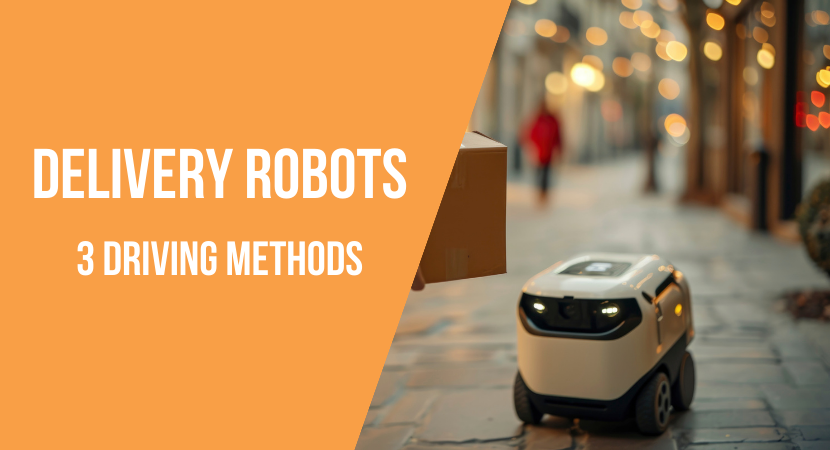 < br>
< br>There are several types of automatic delivery robots in terms of driving methods. Let’s compare each and find the most suitable option for your company’s installation environment.
- Autonomous driving type (self-driving type)
- Autonomous driving type (guide type)
- Automatic tracking type
Autonomous driving type (self-driving type)
Autonomous delivery robots (self-driving type) combine advanced sensor technology and AI to understand the environment and automatically deliver packages to their destinations along the optimal route.Using technologies such as cameras, LiDAR (Light Detection and Ranging), and GPS, it uses high-precision 3D maps to analyze your surroundings in real time and navigate to your destination while avoiding obstacles. .
The robot does not rely on programmed routes and can respond to dynamic environmental changes, making it suitable for use in urban areas and complex terrain.
The features compared to other types of delivery robots are as follows.
- Reacts and adapts to unknown obstacles and changing conditions in real time
- A combination of advanced sensors and AI allows autonomous robots to function in urban areas with mixed traffic and obstacles.
This type of driving method is useful in the following situations.
- Available to offer same-day delivery to online shopping customers in narrow streets and crowded urban areas
- Automate delivery of medicines and specimens within hospitals
- Ability to deliver documents, food, materials, etc. between multiple buildings within a large campus or facility
Autonomous driving type (Guide type)
Guided autonomous delivery robots follow a specific route according to pre-installed guides (magnetic tape, markers, RFID tags, etc.).This system is easy to set up and maintain, and works well in certain environments that require the same routes over and over again. However, it is difficult to respond flexibly to unplanned route changes.
Guide type robots have the following characteristics compared to other self-driving robots.
- Low installation and operating costs and easy initial setup as no advanced sensors or AI are required
- Very stable operation is possible as the operation follows a predetermined guide
- Unable to respond flexibly to changes in the environment
- Less technical troubles, easy maintenance
The following are situations in which guide-type robots are particularly useful.
- Used to transport product parts and materials between specific production lines in a factory, contributing to improved production efficiency
- Automating product pickup and placement in the warehouse
- Transportation of specimens, documents, medicines, etc. within the hospital between specific departments
Automatic tracking type
Auto-following delivery robots have the ability to track people or other robots, and automatically follow a specific target.This type of robot is often used to transport packages in shopping malls or hospitals, using tracking technology using cameras, sensors, and sometimes specific signals and tags.
When a user loads a package into a robot, the robot follows the user and transports the package to its destination.
The main features of automatic tracking robots are as follows.
- Works based on user movement, so route can be changed by user
- Controlled by direct user intervention and works while interacting with the tracked target
- Flexibly adapts to the usage environment and can be used in a variety of situations
Specific scenarios in which automatic tracking robots are useful are as follows.
-
Automate delivery from check-in counters to security checkpoints and gates so travelers don’t have to carry heavy luggage around the airport
Used to carry medicine and personal belongings as patients and nurses move around the hospital, with robots following the patient’s movements.
At large shopping malls and supermarkets, robots can follow customers as they continue shopping, loading items into carts and eventually transporting them to the cashier or car.
Status and challenges of demonstration experiments of automatic delivery robots
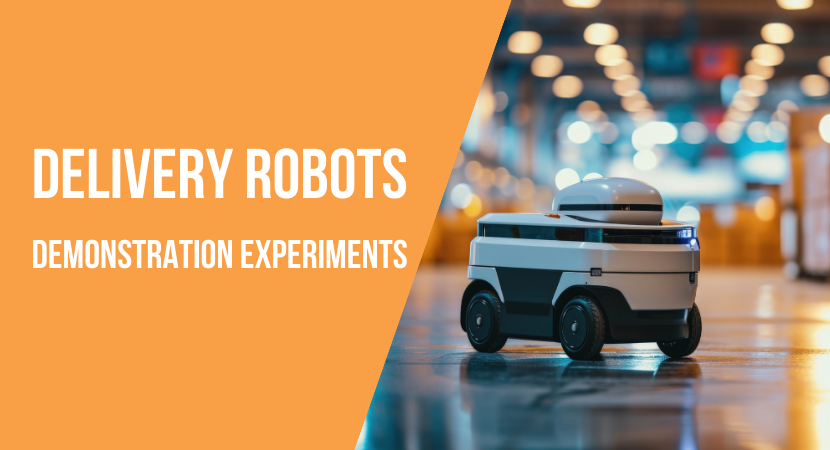
To date, various companies such as Panasonic, Honda Motor Co., Ltd., and Tier IV have conducted demonstration experiments on automatic delivery robots. As a result of these efforts, autonomous delivery robots have been allowed to operate on public roads since April 2023, steadily expanding their potential.
On the other hand, some companies say that there are still issues with the speed and accuracy of sensing the situation and making instant decisions.
For example, if a bicycle approaches from the opposite direction while the robot is moving along the edge of a sidewalk, the robot must instantly determine whether the bicycle should take a detour or risk collision. It seems that there is still room for improvement in managing such uncertainties while ensuring smooth delivery without compromising efficiency.
Advantages and disadvantages of Delivery Robots
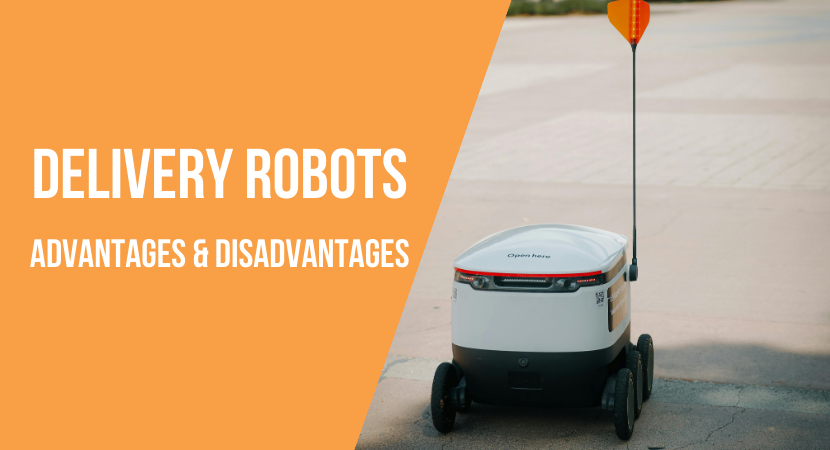
Delivery robots are currently being developed by various companies, and legislation is also being developed to allow them to be run on public roads. There are both advantages and disadvantages when introducing new robots into society.
Let’s compare each to see if you can enjoy the maximum benefits with the usage method you envision.
Advantages
Delivery robots have the following advantages:- Eliminates labor shortage
- Contactless delivery possible
Can solve labor shortage
By introducing delivery robots, you can resolve delivery problems caused by labor shortage.For example, delivery robots have the potential to alleviate labor shortages in the following ways:
- Improving the efficiency of the final stage of the delivery process, the part that delivers the product to the customer (last mile delivery)
- Ability to respond to increased delivery demand during specific times or seasons
- Automate the picking, sorting, and transportation of products in the warehouse in internal logistics and warehouse management
This advantage is particularly likely to be useful in the following situations:
- Delivery in depopulated and sparsely populated areas
- Distribution of supplies at elderly facilities and hospitals
- Security and maintenance for large events and facilities
Contactless delivery possible
Contactless delivery through the introduction of delivery robots is particularly effective in preventing the spread of infectious diseases, contributing to improved safety and convenience.In particular, contactless delivery has the following advantages:
- By avoiding physical contact between the delivery person and the recipient, the risk of infection is significantly reduced
- The recipient can receive the package automatically without waiting for the delivery to arrive
- There are no restrictions on delivery time or location as the recipient can pick up the item at any time
Situations where contactless delivery is particularly important include:
- Drug delivery at hospitals and medical facilities
- Food delivery service
- Mail delivery to office buildings and apartments
Disadvantages
On the other hand, delivery robots also have the following disadvantages: After understanding these, you need to consider whether the advantages outweigh the disadvantages.- Introduction cost is high
- Unexpected risks such as mechanical failure may occur
Introduction cost is high
Delivery robots require high initial investment, which can have a significant impact on your business’ financial planning.Implementation costs include not only the cost of purchasing the robot itself, but also the cost of setting up the system, maintaining it, and training employees if necessary.
The price of typical delivery robots varies greatly depending on their functionality, size, and technological advancement.
For example, a simple robot used indoors on a small scale can cost several thousand dollars, while a large outdoor delivery robot with more advanced autonomous driving capabilities may require an investment of several hundreds of thousands of dollars or more. Robots with extremely advanced technology can cost millions of dollars.
In Japan, delivery staff’s labor costs are often calculated on an hourly basis, and although it varies depending on the region and working conditions, it is generally between 10 to 15 USD per hour. If you work full-time for 160 hours a month, your monthly labor costs will be around 1600 USD to 2400 USD.
Introduction of delivery robots requires a large initial investment, but once they are operational, there are no additional labor costs, so long-term cost reductions can be expected over several years.
Considering the robot’s operating time, maintenance costs, and efficiency improvements after implementation, the total cost may be lower than the labor cost over several years of operation. However, it is difficult to recover investment in a short period of time, so it is necessary to carefully evaluate the investment recovery period and improvement in operational efficiency.
Unexpected risks such as mechanical failure may occur
The main disadvantages of using delivery robots are mechanical breakdowns and technical problems.Robots are comprised of complex electronics, software, and mechanical components that can cause unexpected problems and downtime. Failures can disrupt the delivery process and, in the worst case scenario, have a significant impact on customer service.
Examples of possible risks include:
- Failure of physical parts such as robot motors, sensors, batteries, etc.
- The robot may not function properly due to software bugs or compatibility issues
- If a communication error or system failure occurs, it becomes difficult to control and monitor the robot
- Potential performance degradation due to extreme weather conditions or unforeseen physical obstacles
To avoid these risks, the following measures can be taken.
- Regular maintenance and inspection
- Introduction of redundancy (backup function that allows other parts to continue functioning even if one part fails)
- Comprehensive maintenance agreement
- Staff training for troubleshooting
- Developing a backup plan
Four selection criteria | How to choose a delivery robot
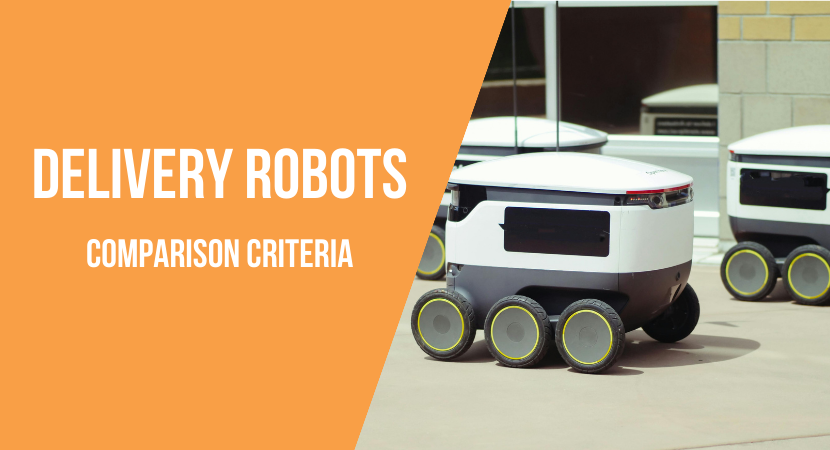
There are various types of delivery robots, and choosing the appropriate one will help you achieve your company’s objectives.
In order to make the best possible choice, we recommend selecting a delivery robot after carefully considering the following points.
- Performance
- Suitability for delivery scope and delivery material
- Price
- Support for robot manufacturers
Performance
High-performance robots can complete delivery tasks quickly and accurately, providing reliable service over long periods of time. On the other hand, robots with good performance tend to be expensive, and it takes time to recover the costs.By choosing a robot with the right performance for your specific needs and environment, you can reduce operating costs and improve customer satisfaction.
Among the performance points, the following are the points you should pay special attention to.
- Safety features such as collision avoidance systems, emergency stop functions, and safety warning systems
- Robot battery life and charging time
- Ability to adapt to suitable weather and terrain, whether for indoor use only or suitable for outdoor environments
- Ability for robots to communicate effectively with central systems and operators
For example, if you are introducing a delivery robot for the following purposes, you will need to check the following items.
| Usage | Items to check |
|---|---|
| Logistics within factories and warehouses | Durability, safety, maximum operating time Strength to withstand continuous operation in a factory |
| Delivery service at university campuses and resort facilities | Suitable delivery environment, communication capabilities, and movement speed Appropriate navigation ability and speed to cover a wide area |
| Delivery of industrial products | Maximum load capacity, durability and safety High load-bearing capacity and robust construction to transport heavy industrial products safely and reliably |
| Large-scale delivery of furniture and home appliances | Maximum load capacity, durability and maneuverability Ability to carry large and heavy items and ease of handling at the delivery point |
Suitability for delivery scope and items
When choosing a delivery robot, considering the scope of delivery and suitability of the goods to be delivered is very important to ensure an efficient and effective delivery system. By selecting a robot that is appropriate for the nature of the item to be delivered and the scope of delivery, it is possible to improve the safety of products during delivery, maintain quality, and improve delivery efficiency.The following points should be especially noted regarding the delivery range and items to be delivered.
- It is necessary to choose a robot with appropriate size and maneuverability depending on the size of the delivery area and the narrowness of the aisle
- When handling temperature-sensitive products such as food and medicine, a robot with heat or cold insulation is required
- If the cargo is fragile or expensive, a robot with good vibration absorption and fixing capabilities is required
For example, in the following applications, we recommend checking the following items.
| Usage | Items to check | Details |
|---|---|---|
| Logistics within factories and warehouses | Mobility, durability, load capacity | In factories and warehouses, a wide variety of goods are frequently moved, so robots with high durability and appropriate loading capacity are required |
| Delivery service at university campuses and resort facilities | Mileage capability, personal safety features, climate responsiveness | It is important to choose a robot that can travel long distances to cover a vast area and can operate safely in environments with many people |
| Delivery of industrial products | Maximum load capacity, durability, safety | To transport heavy industrial products, robots with high loading capacity and strong structure are required |
| Large-scale delivery of furniture and home appliances | Loading space, load capacity, and safety according to size and shape | In order to safely transport large furniture and home appliances, a large and sturdy robot is suitable, and a design that can reliably protect the goods is necessary. |
Price
Considering the price of delivery robots is essential to ensure cost efficiency and financial sustainability. The price of a robot greatly affects not only the installation cost but also the long-term operating cost.Appropriate budget allocation and cost management will make your delivery system more efficient and allow you to make reasonable investments.
When considering price, the following are some of the things to consider:
- Introduction costs: one-time purchase costs when purchasing a delivery robot, and initial costs and regular payments when leasing or renting a delivery robot
- Maintenance costs: regular maintenance, repairs, parts replacement, etc.
- Operating costs: power consumption, training costs for staff if necessary, etc.
By properly evaluating these points, you can optimize not only the initial investment but also the cost-effectiveness of long-term operations and increase the sustainability of your business.
Robot manufacturer support system
When introducing a delivery robot, it is important to carefully consider the robot manufacturer’s support system. There are several reasons for this, primarily the long-term success of capital investments and maintaining efficient operations.A quality support system enables quick and effective resolution of system troubles and operational issues as they occur, helping to minimize downtime and maximize productivity.
Minimum support options include:
- Technical support: Expert support via phone, email, or chat
- Parts supply: Promptly provide necessary parts in response to breakdowns and wear and tear
- Maintenance contract: Provides regular maintenance and inspections to maintain optimal robot performance
- Online Resources: Provides access to self-help resources, including user manuals, FAQs, troubleshooting guides, and educational videos
- Training program: Provides training to help users learn how to operate the robot and get the most out of it
In addition to this, companies with a strong support service may receive the following benefits:
- 24/7 Support: Customer support available at any time
- On-site support: In case of an emergency, a technician will come directly to the site to resolve the problem
- Remote monitoring and diagnostics: remotely monitor robot performance and notify you immediately of any abnormalities
- Customization and integration support: Helps customize robots to meet customers’ specific needs and integrate with existing systems
- Extended warranty and upgrade options: Extend your warranty and provide future upgrade paths
With generous support, you can install and operate delivery robots with confidence, but in most cases you will need to pay a corresponding fee. Be sure to get the necessary support and budget in order before proceeding with the introduction of delivery robots.
Delivery Robot Manufacturer Comparison
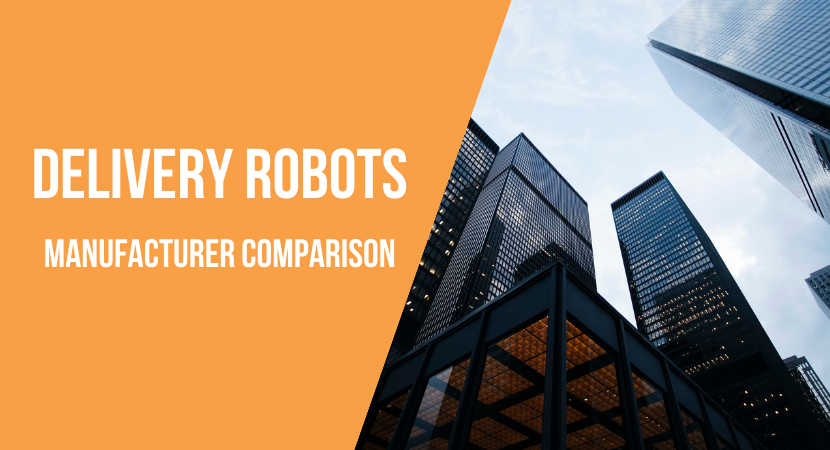 < br>
< br>Over time, many new companies are entering the manufacturing and provision of delivery robots. Let us now take a closer look at five major delivery robot manaufacturers and see what sets them apart from each other.
Hakobot
Hakobot is a robot manufacturing company that specializes in delivery robots, founded in May 2018 in Miyazaki Prefecture. Based on the philosophy of “carrying anything and transporting it reliably,” this company is focusing on developing delivery robots that have both high traversal performance and easy-to-use operability.Since its establishment, Hakobot has aimed to automate the last mile delivery process in order to streamline delivery services. The company is developing Hakobase Version 2 and is also conducting demonstration experiments on public roads.
ZMP
ZMP Co., Ltd., established in January 2001, contributes to society with groundbreaking robot technology with the mission of “creating a fun and convenient society.”These robots are supported by the integrated robot platform “”ROBO-HI”” and the automation core engine “”IZAC””. Their goal is to enhance and enrich the expeirence of delivery.
As a pioneer in the robotics venture, ZMP continues to aim to be a “one-of-a-kind entity” with its unique technology and innovative products. ZMP’s journey to lead the future robotics market will only accelerate from here.
Honda
Based on the belief that “technology is for people,” Honda announced the innovative humanoid robot ASIMO in 2000, and has continued to advance the development of robot technology while deepening human research.Looking ahead to a future where robots will blend into daily life, Honda aims to “lead the evolution of mobility and lifestyle for each person around the world, and provide everyone with the joy of expanding their life’s possibilities.” I am.
Currently, Honda is participating in a technology development project promoted by NEDO, aiming to socially implement self-driving robots to meet the rapidly increasing needs for remote, non-face-to-face, and non-contact delivery due to the impact of the new coronavirus infection.
With the goal of solving social issues such as the shortage of delivery personnel due to the declining birthrate and aging population, they have conducted driving demonstration experiments using automatic delivery robots to clarify the necessary functions, performance, and safety requirements, and to solve problems for social acceptance. It is working.
Panasonic
Panasonic Holdings Co., Ltd. is the first company in Japan to receive a notification under the remote-controlled small vehicle notification system based on the “Act for Partial Amendment of the Road Traffic Act” that came into effect on April 1, 2023.This new regulation will allow autonomous delivery robots that meet certain size and construction requirements to be driven on public roads with only documentation required. As a result, Panasonic HD has started operating automatic delivery robots at Fujisawa Sustainable Smart Town in Fujisawa City, Kanagawa Prefecture from July 31, 2023.
A similar notification was also received in Marunouchi, Chiyoda-ku, Tokyo, and demonstration services will begin to be provided there from August 1, 2023. These moves aim to contribute to resolving the chronic labor shortage in the logistics industry and access issues related to purchasing food and eating and drinking.
Panasonic HD is responding to these major social issues by promoting social implementation and developing new usage scenarios for automatic delivery robots.
Tier IV
Tier IV Co., Ltd. was founded in 2015, and its main business is the development and license sales of autonomous driving software “Autoware.” Autoware is an open source self-driving platform known for its widespread adoption by businesses and research institutions around the world.In addition to providing Autoware, the company also develops and sells a wide variety of autonomous robots, including automatic delivery robots and automatic cleaning robots. These robots are equipped with advanced technology to streamline daily tasks and promote automation.
The delivery robot they manufacture is called Logiee, a small automatic delivery robot that specializes in deliveries on sidewalks and driveways. The maximum payload is 30 kg and the maximum speed is 6 km/h.

